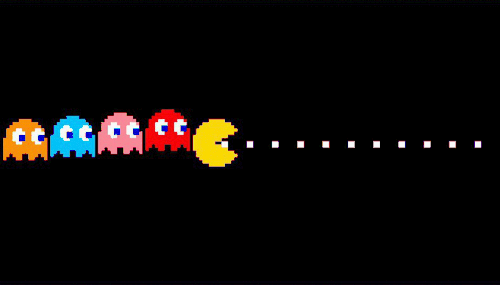I remember a time about thirty some odd years ago, where I would sit at a tabletop Pac-Man game while my grandmother socialized with her friends at a small diner in Simi Valley. I’d have a stack of quarters and would lose myself for hours. Such a simple game yet, here we are. Pac-Man stood the test of time.
Pac-Man came out back in the fall of 1980 and it blew up at arcades to a point where there were lines. Can you imagine? Lines stretching and wrapping around other arcade machines just so folks could be a nondescript yellow circle that ate smaller circles in hopes of eradicating ghosts as a main entree when not filling up on dots and fruit. Any explanation? Nah. Did we need one? Of course not. Pac-Man didn’t really need a lot of information out into the world for people to give it a shot and then willfully allow the spin-offs that vaguely introduced not only his future wife but his child. Nobody asked. We just let it happen and we still lined up, stacked our quarters and encouraged more ghost meals for our round yellow friend.
Want to spend a half an hour and comb through the wordless yet incredulous history of Pac-Man and his family? Check out Andrew Luiz’s rundown of sixty-four games that Pac-Man was the focal point of, or at least secondary in. It’s quite eye-opening as well; I totally forgot that Pac-Man was a playable character in Capcom’s Street Fighter X Tekken. Wait until you get to that part, it’s pretty thrilling.
It was a nine-man team that was headed by Toru Iwatani that programmed Pac-Man, a simplified design that was meant to engage not just men in arcades but also women and children. Inspired by the concept of Popeye the Sailor, it was thought that the entire game is about getting to those power pellets, becoming larger than life, and ridding the playing field of its mostly unstoppable enemies. Because its popularity soared, Pac-Man is considered the original video game mascot. People knew what Pac-Man was when it released, even if they had never even touched the machine he was born from. How many video games do you know of had a Billboard Top Ten song inspired by it?:
What a time to be alive, right? You had Buckner and Garcia crooning about having Pac-Man Fever on the radio, businesses paying out to get Pac-Man machines in their establishments and even young people pushing to be the first to have the highest score. If you’re wondering when the intensity of video games truly started in the mainstream, it was with this little yellow ghost-munching fella and the litany of people from all walks of life that lined up to get a turn.
This meant that a young five year old me could sit at that silly little diner with a Shirley Temple leaving a glossy glass ring on its acrylic surface, pounding quarters into it to while the hours away. Sure, I didn’t understand Pac-Man Fever for quite some time, didn’t even appreciate it fully, but when I did — I found myself lost in the veritable sauce of how such a simplistic character could capture people over three decades, nearly four. In a moment of our lives where video games are hooked on realism and where the landscape flourishes with games of every type, setting and style – Pac-Man still thrives. Simple can explain its visuals, for sure, but it definitely doesn’t define what it has become over its tenure.
And that, right there, is why we always return to Pac-Man. We’ll be chasing those ghosts forever.



